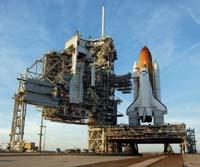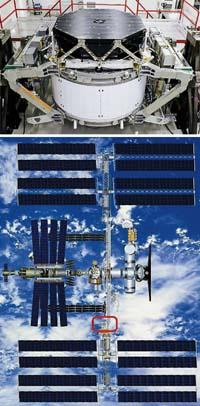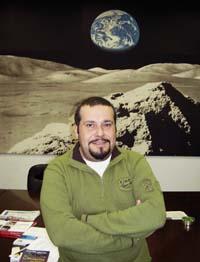ISS, from hope to hopelessness

The Columbus module is the largest contribution of the ESA European Space Agency to the International Space Station, ISS. It has been a work of many years, as ESA approved the Columbus project in 1985.
The module has a length of seven meters and an approximate diameter of four and a half meters, with capacity for ten experimental compartments. In addition, four other exterior compartments can be placed. However, for the moment, only half of them.In one of the interior compartments (Biolab) you will experiment with small plants, microorganisms, cellular cultures and other living beings. Another compartment is Physiology (EPM) and is prepared for medical tests such as brain scanners and circulatory apparatus.
In addition to biosciences, other experiments will be carried out such as a compartment (FSL) dedicated to fluid science, and another (EDR) where technology and telecommunications tests will be conducted. The last interior compartment is the warehouse. Outside there are tools for observation and analysis of the space, as well as tests that must be carried out directly in the space, as is the case of TRIBOLAB.
All planned experiments will be performed by three astronauts on the ISS. In the same mission of connecting the Columbus to the ISS, the crew will be modified by the thief Leopold Eyharts who will replace astronaut Daniel Tani.

Therefore (all in good way), the ESA will finally have a laboratory in the space for long-term experiments in microgravity. In fact, this was one of the objectives of the ISS from the beginning, to be a stable laboratory of scientific experimentation, taking advantage of the space conditions to perform impossible tests on Earth. One of these conditions is microgravity: The force of gravity on the ISS is 88% of the existing at sea level.
Not everything is gold
Even fulfilling this goal, success would not be total. Like the space station itself and many other projects related to it, there have been delays and incidents.
For example, in December it was planned to send the Columbus to the ISS with the help of the ferry Atlantis. However, they had to delay the launch more than once due to a failure in one of the sensors to control fuel tanks. They finally decided to leave it earlier this year.

TRIBOLAB is just one example. As in stores in January, in the seasonal space there are discounts for one reason or another: budget cuts, lack of resources, reduction of objectives...
According to astrophysicist Javier Armentia, to a certain extent it is not surprising that these circumstances occur, since the project is very ambitious and in that case there are many factors that influence the route, being normal that changes in the direction and the deadlines occur. However, in this case the changes have been far superior to those foreseen.
This has caused frustration to many. Robert Park, for example, is director of the Washington Physicists Association and is an expert in the NASA space program. It is very critical and thinks about the ISS that the only reason for the construction of the space station is, at this time, its completion. And it's not the only one who has that opinion.

Armentia recalls that two main objectives were the creation of the space station. The first was to create technology to build a station that remains in space for a long time and complete the station in parts. In this sense, he believes that the ISS has succeeded. In addition, since November 2000, astronauts have been permanently rotating around the ISS. The second objective was to have a laboratory and do science outside the Earth and, according to Armentia, "this has not developed as expected."
No money
The latest report that NASA itself has prepared for the US Congress also has a tone of despair. In fact, ISS is an international project involving 16 countries (Canada, Japan, Russia and ESA members), but the United States is making the greatest effort, both economically and technologically, and does not have sufficient social protection to maintain it. It also seems that they do not expect this protection to increase. In fact, NASA, in its congressional reports, tries to 'sell' its projects using all the tricks of propaganda. The ISS report is simple and simple.
They do not hide the problems and have great doubts about the future. They recognize that travel to the ISS has been enormously complicated after the accident suffered by the Columbia transbordadora in 2003. Now they rely heavily on Russia, which rents the Soyuz spacecraft to NASA to bring and bring astronauts to the ISS, as well as the Progress ships to transport material, but these ships do not return to Earth because they are not prepared to enter the atmosphere. In addition, Soiuz is associated with the ISS so that astronauts can return from the ISS in an emergency.
The dependence on Russia is very expensive to NASA and not only money, society does not see with good eyes pay the Russians, which damages the image of NASA. To solve this, it would be best for NASA to develop its own packaging. However, after the Columbia disaster, the US space program has taken a new direction and NASA's main objectives are now the Moon and Mars. And within this there is no intention of making any kind of packaging that will serve for ISS travel. However, it is expected to be used until 2016. The other international partners, of course, could use it from there.
No progress
Despite the ferries, the ISS has many other problems. First, deadlines. Everything has been delayed. In principle they wanted to have it done by the year 2000. It was not a bad idea to complete the millennium; it would be good publicity. Now NASA has set the limit in 2010, but some talk about 2012... However, little will have to do with the initial version, as it will have much less modules than then.

Undoubtedly, for the crew the presence or not of this module is very different, but the abandonment of other tools and modules is more important from the scientific and technological point of view. These include the AMS spectrometer (Alpha Magnetic Spectrometer) and the CAM module (Centrifuge Accomodations Module). The first serves to analyze dark matter and the second to experiment in controlled gravity, but neither will be taken to the ISS for lack of money and resources.
Another problem is the aging of materials. In space there is a rapid deterioration and aging of the materials and some parts of the ISS have more than ten years of existence. It should be noted that in 2000 it was considered to work and, due to delays, the aging of materials is now more evident.
Furthermore, the expected scientific advances have not materialized. For example, the state of microgravity sought to synthesize new proteins and molecules. In fact, gravity involves a certain bending of proteins on Earth. Without gravity, proteins could have another structure, so they would work differently. In this way new medicines were intended.
However, it has not been possible to conduct experiments with ease. If a pharmaceutical company or university has a project at ISS, first you have to present it, then select it and then design it so that it can be carried and done there. In addition, the experiment will be carried out by an astronaut and although the astronauts are prepared, they can not introduce changes, so it is also lost the opportunity to introduce improvements that the researcher can make at a certain time taking inspiration. It is very limited, which has led to the decline of many stakeholders such as the pharmaceutical company.
It is also an ideal place for performing physics experiments and creating new materials. However, the applications developed there are not possible on a large scale, so the industrial sector is not very useful. Some experiments are being carried out, but, as Javier Armentia says, "if the displacement to the ISS was easier to investigate, it would be much more successful."
In the future, what?
The ISS, for its part, is appropriate for physiological research and study how it affects the human body to space and has deepened much in it. Undoubtedly, the experiences and experiments with living beings of the ISS astronauts will be useful for future missions.

However, it is clear that neither for the United States nor for the rest of the members, the ISS has no priority and it seems that they just want to finish it for once. Somehow they give the reason to Robert Park. They have already forgotten their dream of being a laboratory hung in the sky of the ISS, where the seven astronauts would develop very useful applications on Earth and...

The dream is over. For the moment, it is expected to complete completely, while it is an ideal hotel for rich tourists. The station received in 2007 five tourists who used Russian 'taxis', which cost 17 million euros each. A wedding was also held: Yuri Malechenko's cosmonaut, on the ISS, married Ekaterina Dimitrieva. The bride was in Texas and the case was given by the cameras.
Will that be the future of the ISS, become an expensive hotel for rich? Armentia considers that the worst thing is that the ISS can kill for many years any project of long-term permanence in space. He fears repeating what happened to Apollo: "In the Apollo 11 mission, when man first stepped on Earth, a great step was taken for humanity. The following did not stand out so much (except for Apollo 13, which was about to become a tragedy). Apollo 17, last, did not appear on newspaper covers. And it's been 30 years for man to send him back to the Moon."






